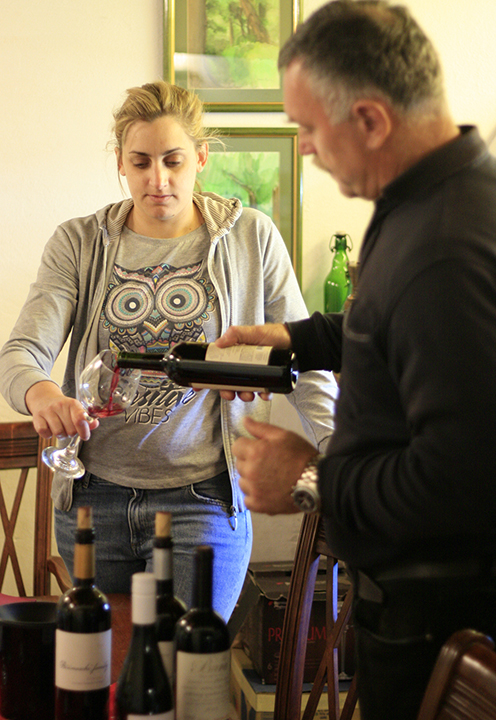
Located on the Pelješac Peninsula, near the Dalmatian coast, the Bura Mrgudić Winery is run by siblings, Mare Mrgudić and Niko Bura and is one of the top artisanal wineries in Croatia. Their vineyards, located on the "cru" slopes of the Postup and Dingač areas are so steep that they can only be worked by hand. Plavac Mali is the grape that thrives in these challenging conditions. In Croatian plavo means blue; mali means small. In 1998, while researching the origins of Zinfandel through DNA fingerprinting, Dr. Carole Meredith at UC Davis with help from the Croatian Napa-based winemaker Mike Grgich and researchers from the University of Zagreb discovered that Zinfandel is actually one parent of the Plavac Mali grape.
Grape Collective talks to Boris Mrgudić, the son of Mare Mrgudić, about Croatian wine and the unique story of Zinfandel.
 Boris, talk a little bit about the family estate, Bura.
Boris, talk a little bit about the family estate, Bura.
Boris Mrgudić: First of all, we are kind of two families because my mother was Bura, maiden name, and Niko is her brother. The Bura family has tradition in grape-growing here in Dingač vineyards and around this part of the peninsula. From my father's family, we have the tradition of growing down a little bit on the west, in the Postup area. Therefore about 20 years ago, in 1995, we started to do wine together.
We are doing different wines from about eight hectares of the vineyard both families have in their possession. Our different labels they focus on the different vineyards where the grapes come from. Most of the grapes that we are harvesting are Plavac Mali grapes.
Talk a little bit about Dingač, where we are right now. It's a very unique area.
Yes, Dingač is a very unique area indeed. As you can see, it's very tough, hard, big slopes towards the sea. Dingač was the first vineyard to be protected as a DOCG at the time, especially geographically protected area back in 1961 from the Yugoslavian government. It was the first, actually, red wine to be recognized as a premium red wine at that time. So it's about 55 years ago.
The most uniqueness of the Dingač is, first of all, the terrain. This small area, as you can see from the hillside to sea, it's very small, but still we have lots of vineyards on these terraces going down. The soil, as you can see, it's brown dirt with clay rocks which is very full of minerals, especially potassium. That's what, in this microclimate, this environment, gives the Plavac Mali grapes the best conditions to grow.
First of all, during the summertime, the temperature rise very high and the grapes kind of are baking here in the oven. We say that Dingač has three sun, sunshine, because the sun comes directly from the sun. You can see here, on this blue sky, you can see over there as the sun goes, the sunshine reflects from the surface of the sea and creates kind of a mirror effect towards the vineyards, toward the grapes in July and August, and that's the second sun that comes.
Also these hillsides, because of the terrain a little bit above us or by us, the stones that our ancestors built, they all kind of warm up during the summertime and create, I would say, kind of an oven effect. The temperature rise above 50 degrees Celsius during the late summertime. The grape is baked and what's the most common is that just give the Plavac Mali the best results. We tried, we plant some other ones, but they just cannot stand such an environment. The Plavac, the tougher it gets, the harder it gets, it gets better.
So talk about Plavac Mali. It's a very unique grape and this is really the home of it.
Yes. First of all, you have to know that Plavac Mali comes from Zinfandel. It has been genetically proven now, for the last 10 years, that the original Zinfandel, actually, the grape variety we call Crljenak here in Dalmatia, is the father of Plavac Mali. Back in the 1900s most of these vineyard were planted with Crljenak, actually Zin. After Phylloxera, most of this variety died out and the Plavac comes as a breed from original Zin, Crljenak, and Dobricic a local variety from the island of Solta. Later on, in the last 80 years, the variety of Plavac are planted all over Dalmatia. Most, like 80%, of the Plavac production is here on the peninsula of Peljesac. Not only on these hillsides of Dingač and Postup down west, but also on the other side of the valley.
The most uniqueness, in my point of view, to the Plavac Mali is that this grape right here, which is a little bit thicker skinned than Zinfandel, so it got a bigger resistance to the higher temperature that we have here, gives the ability to the grape and later on to the wine to get into different kind of areas, a little bit different territories, and could produce, really, such a complex wines by itself, but also very different wines can give the very best of the locations.
Later on we're gonna taste some of our wines, you will see the wines coming from the same grapes, just over the side of the hillside here in Dingač, is such other kind of uniqueness. It's light, fresh, more fruit forward. Then the ones coming from Dingač are big, strong, full bodied. The ones coming from Postup is also, but a little bit darker fruit, a little bit more gentle, like a warmer version kind of thing. If you dry out a little bit more, you will get the nice semi-sweet or semi-dry wines that goes very well with dessert. Everywhere around the world, you need to have five, 10, different varieties, making cuvees from this, and we just do it by growing Plavac from different vineyards.
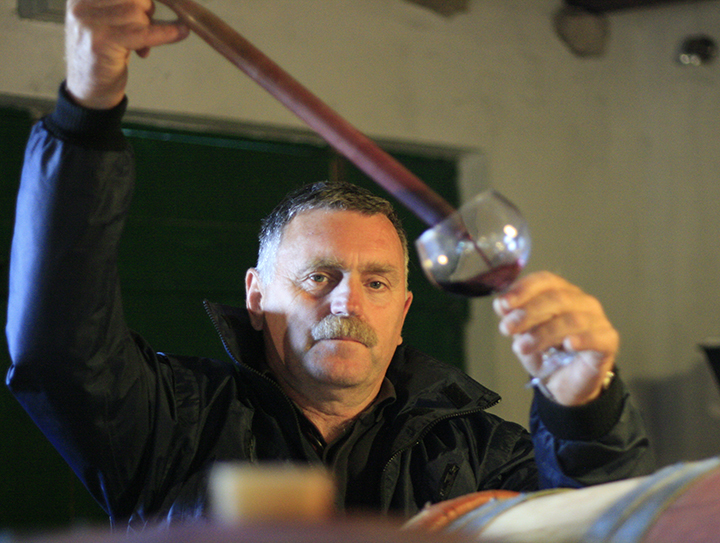
Niko Bura pouring barrel samples of Plavac Mali
Croatia is an old wine region, but also quite a modern wine region in some respects. Can you tell people who are not familiar with Croatian wine a little bit about the different geographies within the country.
First of all, you have to know that we were a part of the ancient world here. These islands all around here were inhabited with Greeks. Greek brought the grapes here. Later on, the Romans continued to harvest grapes. So we have a very long tradition of grape growing and making wine. The other thing which is most important is that during the Socialism period, you have to know that for 50, 60 years during the Yugoslavia, we were kind of trapped in a cooperative system. We had to produce just grapes for the family, for two, three generations. So we were not able to develop the potential of the grape like France, Italy, and other free countries did.
Now that we are on our own, as a country and as a people, with more and more influence and more and more young people going straightforward in their own direction, we have a booming of the wine industry. I often said to people from around Croatia, "Everything in Croatia improved in 20 years like the wine did." If you were drinking some wines from the 90s, the beginning of the 90s, you were drinking so many different wines. Today, you've been around, you see how people are doing here.
The other thing is that many different people are getting into it and giving themself to the wine and giving the creativity to bring the best of the terroir. Beside Dalmatia, where we are at, we are mostly, let's say, red wine because of the sunshine and everything, the warmer climate are more of the place. There are some good white from Pošip, as well as a very unique variety called Grk, but very small production. In Istria, you have grape Malvazjia. People experiment all sorts of things doing it this way, modern way, ancient way even now for us. In Slavonia, there is also a little bit more massive production, but still unique easy-drinking wines.
I think Croatia is becoming the hippie of wine kind of thing. I just came back from the United States and I see people, when they come here in Croatia for a vacation, when they go around, they love, because the wines, not that they are good, unique, but almost every wine is kind of telling the story of a person, of a tradition, of a terroir. People are just willing to bring themself into this and that's why we do it. That's why people like it.
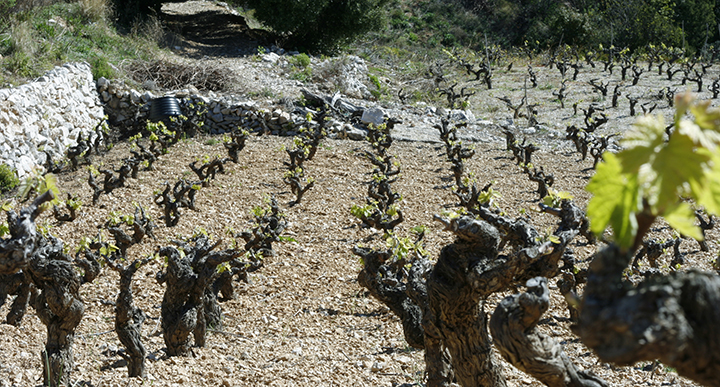 Boris, talk a little bit about the Dingač terroir here.
Boris, talk a little bit about the Dingač terroir here.
So, the Dingač uniqueness is, first of all, it was the first wine recognized as DOC back in 1961. Even in socialism Yugoslav area, this terroir was recognized as something special. As you can see driving here, it's a very small area. It's a very short kind of area from these hills up to the sea. Our ancestor built the walls here on this kind of a fertile soil because the soil is not very rich and you can see it's brown dirt with clay stones that came as the valleys from with drainage around it. The people built these stone walls to protect this fertile soil and to grow the wines.
Also, the uniqueness of the microclimate is that in such a short small area, we have, as we say, three sunshines. Directly from the sun, during July and August when the sun is glaring, it's really getting lots of energy into the grapes. Also, you can see here on this sea surface, during the day, you can see over there a little bit starting, becomes a big big mirror and it reflects the sunshine back to do more energy into the grapes. As well, all of these stones around us and all of the rocks, even rocks from the walls around here, they're just full of heat and full of sunshine, and just giving this heat out.
It's kind of like baking out in the oven. The grapes just get so much energy that by the time of the harvest they become raisins. This uniqueness gives the specialty and special character to Dingač wines.
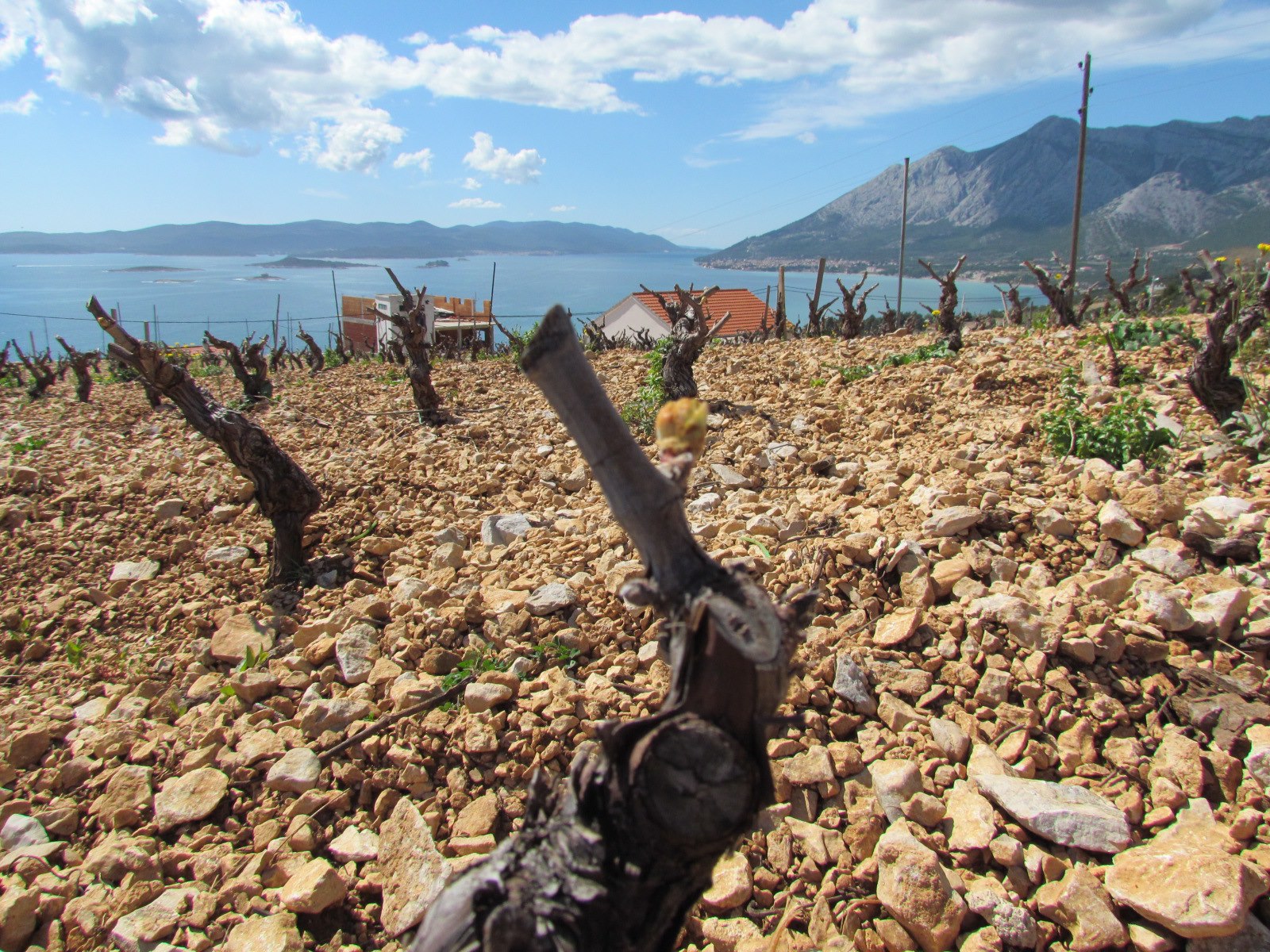 How is the terroir different in different areas of Croatia?
How is the terroir different in different areas of Croatia?
First of all, we are small country. Even here on the peninsula, we are a very small area. But still, like just here on the other side of the hill, in the valley, it's maybe 600 meters from where we are standing now in airspace but it's completely different microclima. Then if you go down to Orebic or you go down to Postup, which is second recognized as a premium in Dingač just five years later, you have also completely different scenario. Not such a big hillside, a little bit smaller slopes, but all these smaller places give to the Plavac grape very different perspective.
You can produce from the same variety, as you will taste later, coming from different vineyards you can produce completely different wines. The gift for us is that we have opportunity to produce the red wine for every day, just to chill, just to go with food, to be very fresh, very fruitful, or to produce big heavy aging potential wines for special occasions, for big hard meals, hard cheeses kind of thing. To even produce semi-dry or semi-sweet wine for desserts and stuff and all this coming from this peninsula or even shorter, smaller area and coming from the same variety of grapes.
Boris, you farm organically. What is the philosophy of winemaking and viticulture at Bura?
First of all, we are small family production. We do it all together, some here and this and the other way. If you be here, you see how the gift of God is the area that we're coming. It's really not hard for us to farm natural, to farm organic, and to do as natural as it can get. Also, that has been our biggest tradition, to grow grapes as natural as they can get. But, as I told you, the microclimate just give us a big kick off in this. If we go to the winemaking process and if we go into the cellar, in producing wines, we rely very much on the tradition. We try to keep up this tradition as much as possible. But also, my sister is now a new young winemaker that just joined us and also you be looking to see what people are doing. We have to rely on tradition but get some things and try some things to bring this wine to the world and to people to understand them better.
We are always straightforward and the one thing is that we aways want to do with our wine, each of the wines has to be perfectly made and has to be the representative of the terroir of the vineyard that it comes from. Not only that and what is most important, every year, because every year is different and every area is, as I told you, a little bit different. Every year we have different conditions in the vineyard. You cannot produce the same wine every year. If you go in that direction, then you are Coca-Cola. Nobody likes to drink Coke anymore.
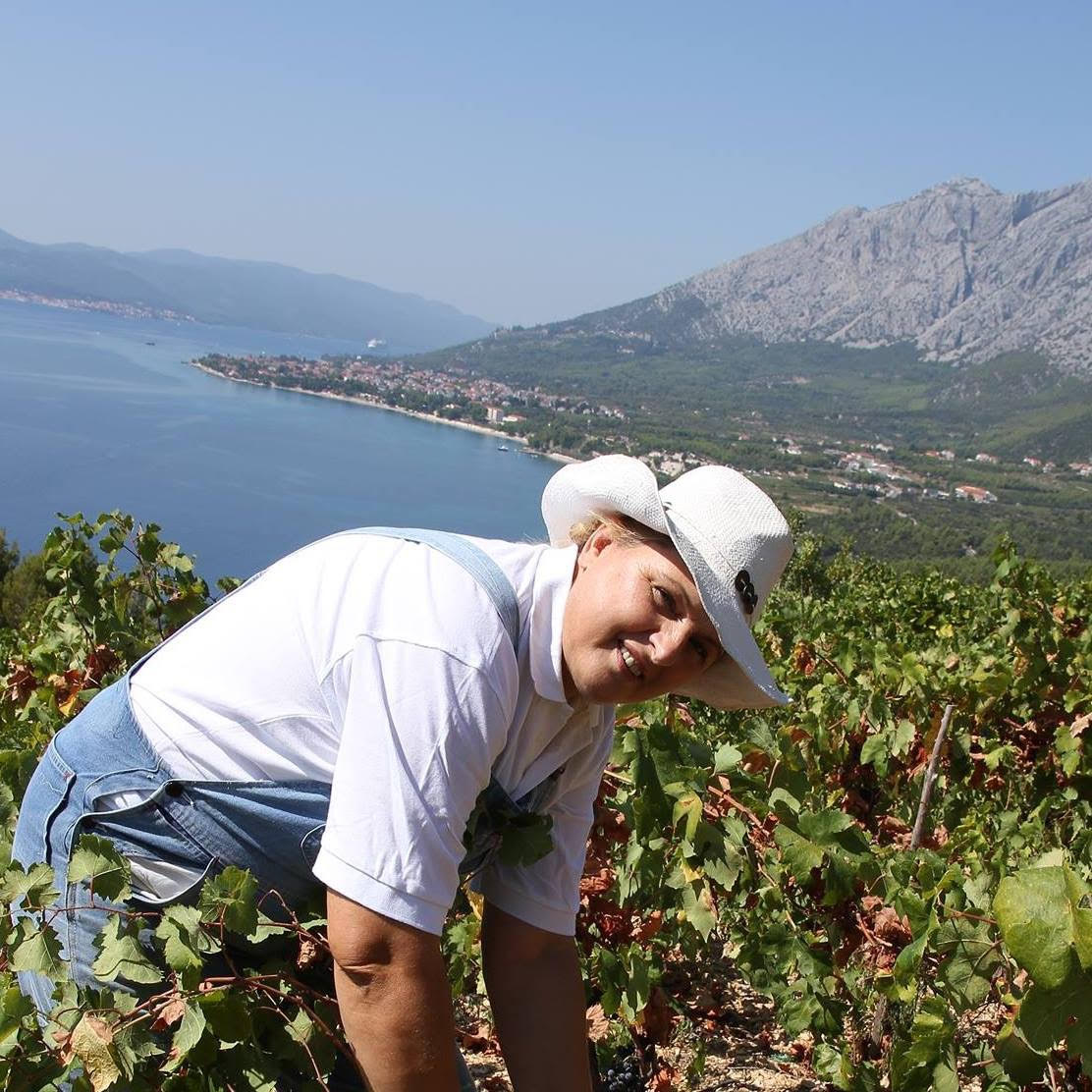
(Photograph of Mare Mrgudić)
Boris, you have an interesting partnership with a very famous American financier who passed recently. Talk a little bit about the relationship with the Benmosche family.
We are very pleased to have such a good relationship with the Benmosche family, Mr. Bob Benmosche, the New York City insurance mogul. He retired here in Dubrovnik and he was a passionate wine lover. Through some friends or some occasions, he got to try some of our wines. He liked it and we started, first of all, hanging out together and trying some wines and becoming good friends. After a few years, our relationship get into a little bit more, I won't say business, but working kind of together relationship.
Today, we are helping Benmosche family to grow the vineyards around here on the peninsula. They have vineyards here in Dingač and in place near Viganj, where we planted Zinfandel. Bob actually went to California and bought about 5,000 plants of Zinfandel, bring it to here, it's a whole kind of a Hollywood story, and started making wine. Even today, it's not a big production. It's much more of a good relationship. Now, when he's unfortunately not still with us, his family, especially his son and the wife, are proceeding with this vineyard and with this wine production. We are all together in this and I think they have very good wine.
Take a 360-degree virtual reality tour of the Bura Mrgudić Winery in Croatia. This experience only works in certain browsers including Google Chrome. You can also experience the VR tour directly on Youtube.
It's interesting, because Zinfandel originated in Dalmatia and you are bringing root stock from California, which originally came from here. So it's gone there and then come back again.
After, when we do all this building up a vineyard and everything, somewhere on the edge of the area, we found out a small plot for three vines. We were thinking "What's this? This is some kind of grapevine. What's this?" We get in the people from Zagreb University to test the vines and they prove out that it's actually the original Zin.
Wow.
So we have built a little bit of a shrine there and it's-
So you have the original Zin and then you have the Zin that came from California which came from the original Zin, so that's pretty interesting.
I told you it's kind of a Hollywood story.
For more on Croatian wine check out Croatia: A Land of Wine Stories by Zeljko Garmaz














